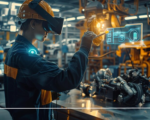In recent years, the robotics industry has been transformed by the emergence of mobile manipulators, which are redefining automation across various sectors such as automotive, logistics, and aerospace. These innovative robots combine the mobility of robotic platforms with the dexterity of manipulator arms, enabling them to navigate complex environments and perform intricate tasks with unprecedented precision and flexibility.
Mobile manipulators, or “MoMas,” are equipped with advanced sensors, cameras, and AI capabilities that allow them to move autonomously and interact with their surroundings in real-time. This technological advancement is crucial for industries that require high levels of precision and adaptability. For example, in automotive manufacturing, mobile manipulators can autonomously navigate assembly lines, placing components accurately and performing quality inspections, thereby ensuring high standards and reducing errors (StartUs Insights) (Control Engineering).
One of the most significant benefits of mobile manipulators is their ability to collaborate with human workers. As industries face increasing labor shortages, particularly in skilled roles, these robots can take over repetitive, dangerous, or physically demanding tasks. This not only enhances worker safety but also allows human employees to focus on more complex and creative aspects of their jobs, improving overall productivity and job satisfaction. By integrating mobile manipulators, companies can streamline workflows, reduce downtime, and cut operational costs (StartUs Insights) (Control Engineering).
In the logistics sector, mobile manipulators are revolutionizing warehouse operations. They automate the picking, packing, and transportation of goods, which speeds up supply chain processes and enhances efficiency. These robots can navigate tight spaces and adapt to dynamic environments, making them ideal for the fast-paced logistics industry. Additionally, mobile manipulators are being used for tasks such as inventory management and order fulfillment, which are essential for maintaining smooth operations in large warehouses (StartUs Insights) (Control Engineering).
Advancements in AI and machine learning are further enhancing the capabilities of mobile manipulators. These technologies enable robots to learn from their environment and continuously improve their performance. Predictive maintenance powered by AI can analyze data to foresee potential issues, allowing for timely interventions that minimize downtime and extend the lifespan of the equipment. This proactive approach to maintenance is crucial for industries that rely on continuous operations (StartUs Insights) (Control Engineering).
As mobile manipulators continue to evolve, their potential applications are expanding into new sectors such as healthcare and hospitality. In healthcare, they can assist with tasks like patient handling and medical supply delivery, reducing the risk of injury and improving efficiency. In hospitality, mobile manipulators can enhance guest experiences by automating room service and luggage handling.
The future of industrial automation is bright with mobile manipulators at the forefront. These versatile robots are not only improving efficiency and safety in traditional industries but are also paving the way for new applications and innovations. As technology continues to advance, the possibilities for mobile manipulators are limitless, promising a future where robots and humans work together seamlessly to achieve greater heights.












